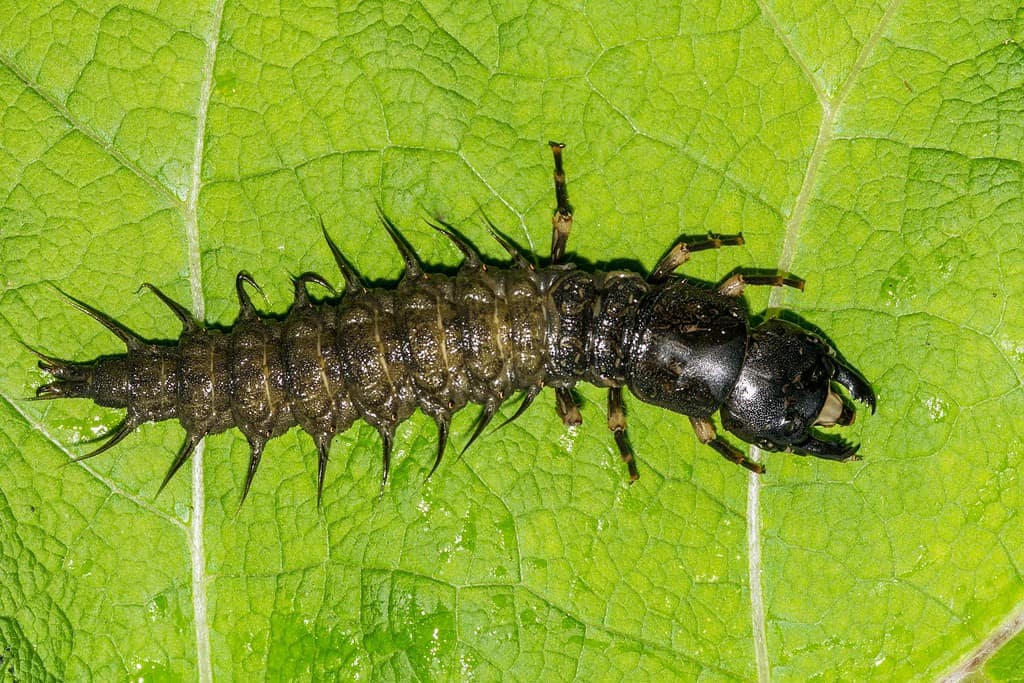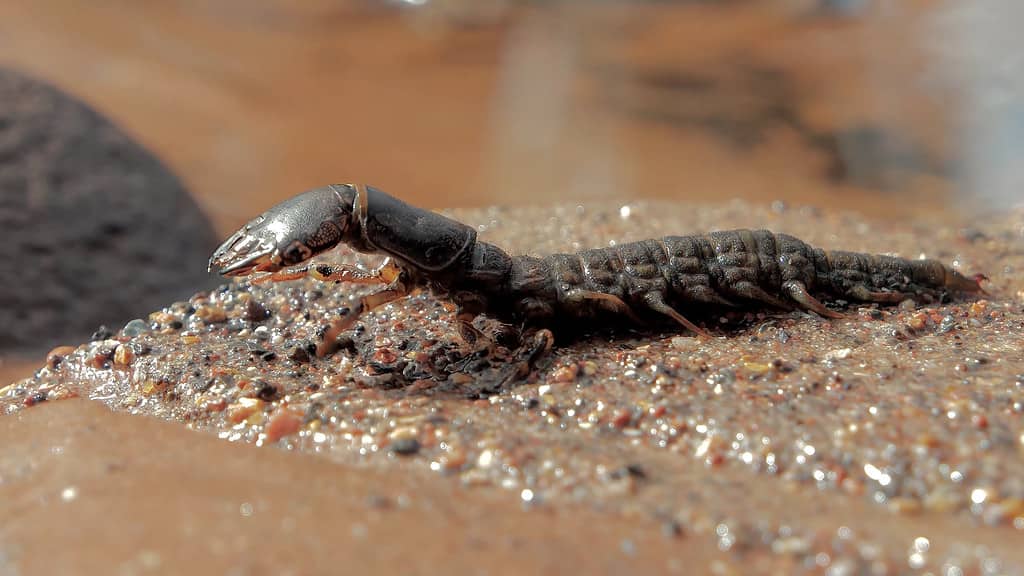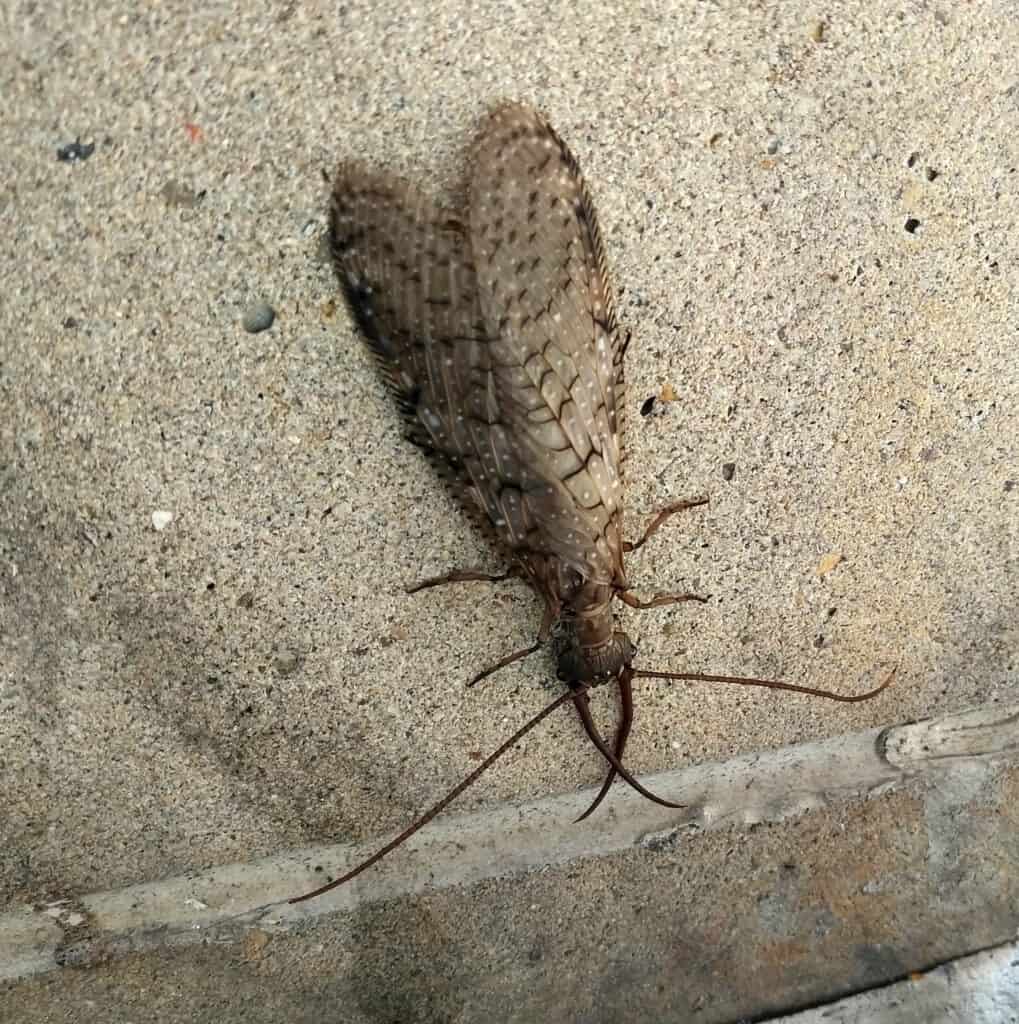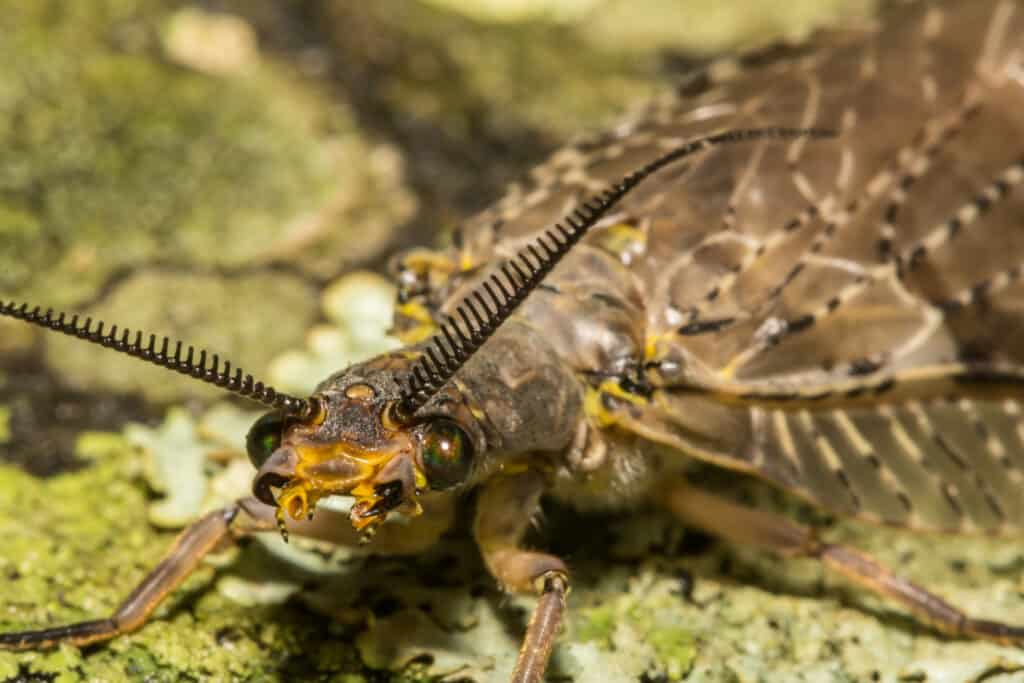Hellgrammites don’t just sound creepy; they are very creepy. Like everything alive on our planet, hellgrammites play an important part, just like all the other creepy crawlies. Once you learn about their lives, you might have a big chunk of respect for the strange, alien-like creatures. These insects go through a lot to be alive for a short time once fully grown! First, let’s look at what hellgrammites are and what could make them creepier once they grow up. If you live near water or enjoy fishing, you might already know a little about these truly weird insects.
What is a Hellgrammite?

Hellgrammites are rarely seen outside of water except when digging a hole to pupate.
©Jay Ondreicka/Shutterstock.com
Hellgrammites are macroinvertebrates and the larva of dobsonflies. They start as eggs near the water shortly after the female has mated. Female dobsonflies will not lay eggs in polluted or contaminated water. Because of this, they are a good indicator of clean water. She will select the perfect place that is best concealed from hungry predators but close enough to the water. This is so the larva, once hatched, can quickly submerge themselves in water without much of a risk of predation or drying out. The mother-eastern dobsonfly lays her eggs on a partially submerged stick, rock, or leaves to protect the unborn hellgrammites. They must be laid in the shade to prevent drying or becoming too warm.
Up to 3,000 tiny eggs are laid with a thin protective sheath around them, which also helps keep the eggs from drying out. The eggs are sometimes laid in layers of up to five levels. The egg cases appear to be bird droppings to predators and humans, so they stand a better chance of survival. The eggs will liquefy in two to three weeks, and the tiny hellgrammites will enter the body of water on their own.
From Egg to Larva

This nearly two-inch-long larva from the genus Corydalus is a fearsome predator.
©troutnut/iStock via Getty Images
The newly hatched hellgrammites have a long way to go before they are ready to leave the water and pupate. For now, they look similar to tiny black centipedes and will remain under rocks, typically in fast-moving streams or small sections of rivers. They feed off of small invertebrates and aquatic insects. The hellgrammites are nocturnal. Once they have molted enough to do so, they even catch and eat small fish.
Over time, the hellgrammites will grow to be 3.5 inches long. They are light brown with dark brown microspines covering their bodies. Their heads are equipped with pinchers to deal painful bites to those who threaten or step on them. On their thoraxes, they have three pairs of legs, then another segment: their abdominal area. Their thoraxal area is covered in black dorsal plates to provide protection. In this segment, they have eight pairs of prolegs, which are leg-like appendages. Along their sides are tracheal gills, which absorb dissolved oxygen. They also have spiracles, allowing them to breathe in and out of the water. At the rear of their bodies, they have another set of prolegs and gills to help them breathe underwater. The anal prolegs are hook-shaped and help to keep them steady in strong currents.
While in the larva stage, the hellgrammites will molt 10 – 12 times before leaving the water to pupate. They molt to grow larger. Each molt takes a lot out of them, and once it begins, they are vulnerable to predators. Some die during the process. This entire water-larva stage can last up to five years, depending on the climate. They might only be in the larva stage for one year in warmer climates, but in colder climates, it could be as much as five years.
From Larva to Pupae

Hellgrammites have powerful pinchers for catching food and defending themselves.
©Banu R/iStock via Getty Images
Once the larva stage draws to a close, the hellgrammites will crawl a short distance of several centimeters to many feet from the safety of the water. They will then dig a hole in the damp soil, typically under bark, leaves, or rocks, and finish the process in their small chamber-like home. This process takes two to four weeks. In Virginia, locals have witnessed hordes of hellgrammites crawling from the water during thunderstorms in late spring or early summer. Vibrations caused by the thunder may drive the hellgrammites to pupate.
Hellgrammites Become Dobsonflies As Adults

Only male dobsonflies have large mandibles.
©Josef Stemeseder/Shutterstock.com
Once the hellgrammite has finished pupating, they crawl from the earth, like zombies do in the movies. The countdown begins since adult dobsonflies only live for a very short time. It is certainly shorter than the time they spend as a hellgrammite. Males will only live for three days on average, and females will live for five to ten days. The adults do not eat and spend their short lives finding a mate and a safe place to lay eggs.
Dobsonflies can be one to five inches long and are soft-bodied. They have antennae and three pairs of eyes. The male dobsonfly’s antennae are much longer than the females’ and may help pick up the females’ pheromone trails. They have light, tannish-grey, translucent wings with dark patterns. They look like they consist of light grey with darker grey colored stained glass.
The Dobsonfly’s Strange Defense Mechanisms
The dobsonflies emerge from pupation and remain near the clean water where they hatched. They wait to find a mate on the vegetation near the bank. The females secrete pheromones to attract a male to her. Both sexes of dobsonflies can produce a very foul-smelling anal fluid when they feel threatened. It is similar to the fluid secreted by stink bugs but considerably worse.
The females retain short pinchers like they had as hellgrammites. These short pinchers can deal a nasty bite to anyone who dares to threaten her. The males, however, have enormous overlapping pincers that are fairly useless. They look treacherous but cannot pinch humans in a painful way. They are for show, and some dobsonflies might use them to hold onto the female’s wings or body when they mate.
Reproduction
The males will go in search of females by following their pheromones. Sometimes, more than one male might arrive for the same female. When this occurs, jousting with their long mandibles will appear, with the winner finding a mate and the loser going off to try his luck elsewhere. Since they are nocturnal, all of this takes place at night. Once the winning male approaches the female, he will touch her wings with his mandibles before mating. Once he gives his bloodline a chance to survive long after he is gone, the male dobson fly will die. Afterward, the female will find the perfect spot to lay eggs, and the entire process will start over.
Interestingly Creepy

One thing is sure: dobsonflies are interesting insects.
©iStock.com/JasonOndreicka
Dobsonflies are strange in many ways and creep many people out every year when they spot them at night. Like moths, dobsonflies are attracted to light and tend to end up on porches. Sure, it can be alarming if you’ve never seen a dobsonfly, but they are harmless, mostly.
Dobsonflies may mingle under bright lights in Virginia and many other places near clean, fast-moving water. These large gatherings can be scary for those unfamiliar with the insects since they sometimes gather by the hundreds. With any luck, this article helped spread the light on these strange and mysterious creatures and maybe even earn them a bit of respect. After all, they go through a lot of work to fly at night for a few days.
The photo featured at the top of this post is © DellaRay923 / CC BY-SA 4.0 – License / Original
Thank you for reading! Have some feedback for us? Contact the AZ Animals editorial team.






